Many first-time puppy owners find themselves at their wit’s end trying to get their new puppy to sleep at night.
Never fear — our One Step Ahead Method is based on evidence from some of the world’s top trainers, and it’s guaranteed to have you and your pup snoozing peacefully through the night in no time!
How to Get Your Puppy to Sleep at Night
Many of us don’t realise exactly how important our sleeping pattern is until it’s disrupted. We find ourselves snapping at co-workers, zoning out on our morning commute, and on the verge of tears or explosion at inconveniences we’d usually dismiss with a shrug of our shoulders.
Just ask any new parent – and pet parents are no exception! So how can you get your puppy to sleep through the night so that you can get some rest?
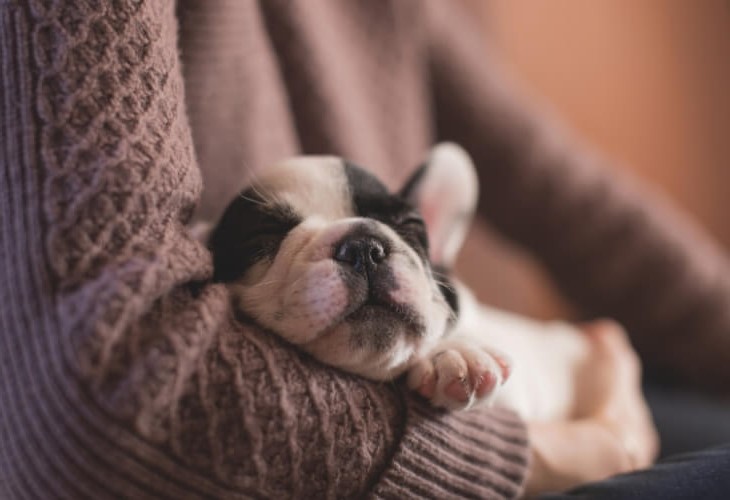
Not getting enough sleep is certainly bad for owners, and it’s not great for puppies, either. All the best training programmes require you to start your training early and face your dog with calm, assertive energy, and it’s difficult to find your chill when you’re so tired that you could cry.
Let’s set some reasonable expectations here — when you first bring your puppy home, they’re entering a new, strange space that they can find quite scary, and their tiny baby bladder just can’t do the job for a full eight hours. You’re not going to have a good night’s sleep for a while!
However, a good sleep training routine can make the difference between weeks and months of lost shut-eye.
That’s why we’ve taken tips from experts Cesar Milan, Doggy Dan, Patricia McConnel and Rebecca Settler and used them to formulate our very own One Step Ahead technique.
This simple method should see you and your new best friend sleeping on the same schedule as soon as possible!
The One Step Ahead Method is easy to follow, designed to anticipate your pup’s needs, and based on the best evidence available.It covers everything from food to toilet breaks to how to burn off your puppy’s energy! We’ll give you all the details later on, as well as some true stories from the frontline of sleep training, but let’s get some basics out of the way first
Where should my puppy sleep?
While the experts are divided on the ideal permanent sleeping spot for your new best friend, almost all agree that your puppy should spend the first night (if not the first few nights) sleeping in the same room as you. Depending on where you got your dog from, this may be their first night sleeping away from their littermates!
Right now, what your pup needs is to feel safe, and having them as close to you as possible is the best way to calm them down. Having your puppy sleep in your room is also a great way for them to begin learning your sleeping pattern — and they’ll have to sync with your schedule eventually.
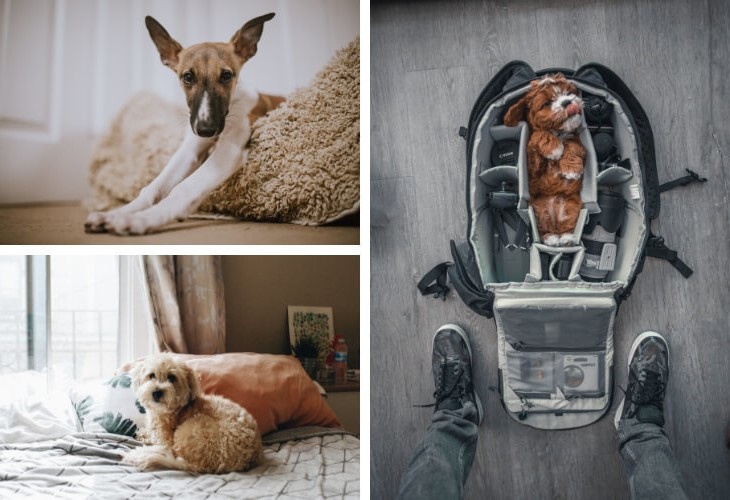
Some trainers, like online training guru Doggy Dan, believe that giving your dog a permanent basecamp in your bedroom decreases their likelihood of seeing you as the ‘pack leader’, and that this can make them anxious and more likely to challenge your authority.
But Rebecca Settler, author of ‘Puppy Sleep Training- The Exhausted Puppy Owner’s Nighttime Survival Guide’, makes the case that since dogs are pack animals, sleeping with members of the pack is likely to make them calmer, and that bedding down in your room is great training for a guard dog.
Wherever your pup ends up resting their head long-term, the first thing you’ll need to do is construct a comfortable, welcoming sleeping area.
Setting the scene: Essential Puppy Props
So how do you create the perfect puppy snooze zone?
Cesar Milan, the Dog Whisperer himself, advises leaving no hard surfaces uncovered.
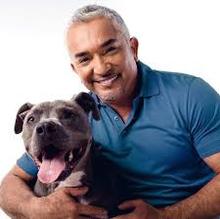
“Everything in the area should be padded, or covered with towels, blankets or newspaper.
If you’ve got your dog from a breeder, ask them if you can have something soft (a blanket, towel or toy) that smells like their litter-mates.
You may even be able to give your breeder something that you own in advance!
It might also be a good idea to add something with your scent on it to the area — it should get your puppy used to seeing you as part of the family!It’s also a good idea to add a toy, for comfort, entertainment, and night-time chewing!”
— Cesar Milan
A particularly nervous pup might get benefit out of something warm, like a hot water bottle, and something that simulates a mother’s heartbeat. You can use an old-school alarm clock covered in blankets, or buy a toy specifically designed for that purpose.
Rebecca Setler believes that a crate or pen is absolutely essential, and that even if your puppy is sleeping in a bed, that they’ll need to be confined.
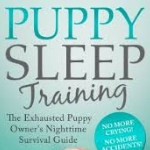
“Setting up an exercise pen around any beds is advisable. New puppies usually feel more secure in small areas, and an enclosed space will stop your puppy wandering off and having an accident in other parts of the house.”
— Rebecca Setler
On the topic of beds — Setler advises against buying anything too destructible at this point. Your puppy will soon start exploring things with their teeth!
Both, Millan and Setler are big proponents of having wee-wee pads in your puppy’s sleeping space, as is Doggy Dan.
Doggy Dan also hammers home the importance of having a bowl of water in the dog’s sleeping area, and seconds the importance of soft materials and toys.

“Stocking the dog’s sleeping area with a couple of options and waiting to see where they bed down — if the dog wants to sleep in a cardboard box, then that’s where the bed should be!”
— Doggy Dan
Essential Puppy Sleep Training Checklist
Here’s a simple checklist to get you started:
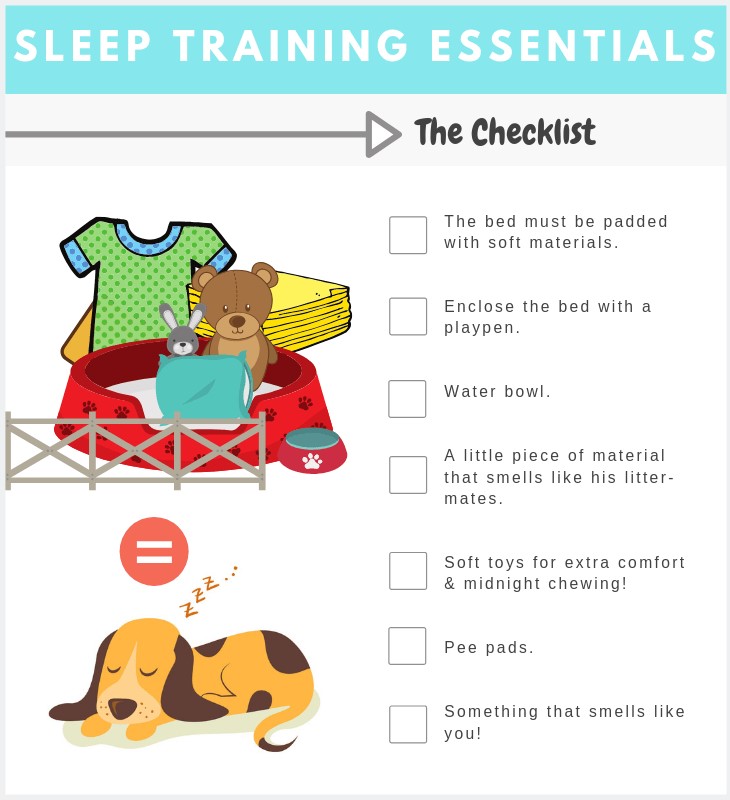
After you’re all set up, you should make sure that your dog doesn’t associate the area with intense activity. Naps and casual hang-outs are fine, playtime and training are not!
Final Thought: For more puppy preparation, click here to check out our New Puppy Checklist!
Be Prepared
Hearing your little bundle of fur cry can be heartbreaking, and on the first night, your puppy is most definitely going to cry. This is a new and scary experience for them!
Humans are evolutionarily programmed to rush to the assistance to crying babies, and while a dog’s cries aren’t quite the same, they’re close enough that we immediately want to respond with cuddles and soothing noises.
This is what Dr Patricia McConnell, author of ‘The Other End of The Leash – Why We Do What We Do Around Dogs’ calls ‘the dark side of empathy’…
“Projecting our own desires onto those who do not share them. Cuddling your dog will do more harm than good, and verbal reassurance will make your dog feel like this behaviour is acceptable. If you tell your dog that ‘it’s okay’ when they cry, they’ll apply those words their behaviour (the crying) and not the situation (the scary space)!”
— Dr Patricia McConnell
You can’t soothe a puppy like you would a baby, but you can give them some reassurance.
Cesar Milan suggests knocking gently on the side of their crate to let them know you hear them. For the most part, though, you’ll have to tough it out.
You might want to bring your puppy home on a Friday evening or some other evening before your day off. The first night is going to be tough, and you don’t want to head into an important meeting having been kept up all night by puppy tears! If you can do it, taking some time off is a very good idea.
Final Thought: Some dog owners have had some success calming their crying puppies by simply laying a hand on their pup and transferring some of their ‘calm energy’ — similar to Doggy Dan’s Calm Freeze technique. To learn more about the Calm Freeze, check out our Puppy Training Guide.
The One Step Ahead Technique
So you’ve set up a lovely sleeping area, steeled yourself for the coming tears, and you’re ready to get down to the business of sleep training.
The goal? To have your puppy sleep on your schedule, of course!
You want them to sleep when you sleep, wake up when you wake up, and to avoid nasty accidents during the night.
With this in mind, it might seem a little odd to think that the best way to get your puppy to work around you is to anticipate their needs. But that’s exactly what the One Step Ahead technique does — it encourages you to think like a dog, counter any problems before they arise, and set the foundations for a peaceful sleep routine.
The best part? After just a few days, you won’t have to deal with any heart-wrenching crying, pitiful whining, or attention grabbing barking from your furry family member at night!
The One Step Ahead Technique has five steps.
Note: When describing this technique, we’re assuming that you brought your pup home when they were about eight weeks old, but these steps should work just as well for older puppies with some minor adjustments.
1. Keep an Eye on Their Feeding Schedule
It should be clear by now that by far and away the biggest reason your puppy wakes you up at night is for a toilet break.
At eight weeks, your puppy should be eating three to four meals a day, and the last one should be no less than four hours before their bedtime. What goes in, must come out!
There’s more to this than just making sure you’re not greeted with a smelly present in the morning, though — digestion keeps your pup’s body and mind active, and can make them restless.
If your own schedule requires you to dish up dinner just a couple of hours before you turn in, consider giving your pup a larger portion in the morning and a smaller one in the evening.
There are some puppies that seem to wake up in the middle of the night out of hunger. If your pup is one of these peckish few, consider leaving a dog biscuit or other snack in their sleeping area.
Cesar Milan suggests a bully stick, or dried bull’s penis — the smell will also entice your pup into his sleeping area!
Rebecca Setler also recommends that you don’t give your pup any water less than three hours before they hit the hay.
But it’s important to remember that dogs can overheat and dehydrate very quickly — while this might be good advice for those in colder climes, you shouldn’t take the risk if it’s hot out.
Bottom Line: Your pup’s last meal should be less than four hours before bedtime and water intake should be less than three hours.
2. Monitor Napping Times Carefully
How much sleep does an eight week old puppy need?
It might surprise you to know just how much shut-eye your little bundle of energy requires — a whopping fourteen-to-twenty hours! Daytime naps are essential for your buddy.
It almost goes without saying that too much sleep in the day equals not enough sleep at night. So here, too, you’ll need to be vigilant!
It might feel cruel to wake your sleeping pup (they look so adorable, after all) but nap-time should stop at least four hours before bed.
If you notice your pup dropping off, wake them up with pats and play. Which brings us neatly to the next step…
Bottom Line: Day time naps should be avoided at least four hours before bedtime.
3. Stimulate the Senses!
This is the most important part. You’ll need to tire your puppy out! But how do you burn off all that new puppy energy?
The answer lies in stimulating your puppy’s senses.
Everything is new to your puppy — new smells, new people, new sights, new sounds everywhere! Finding out about the world can exciting – and pretty tiring too.
This can fit in nicely with your dog’s socialisation training – introduce them to their new pack members, and let them get to know them!
Your puppy needs exercise, of course, but you’ll also need to wear out their brain. Fortunately, playing with your puppy accomplishes both!
Patricia Mc Connell is a huge advocate for using games to teach manners. Your pup might be a little young to master ‘Fetch’, at this point, but a good game of ‘Take It and Drop It’ might just work.
If you’re looking to do a bit more brain work, you might also consider practising some commands!
Of course, you’ll need to keep an eye on your puppy’s energy — there’s a fine line between ‘engaging and having fun’ and ‘overstimulated and unable to respond’.

“Doggy Dan notes that your dog looks to you for cues, and they’ll be responding to your energy levels. So keep it chill!”
— Doggy Dan
Bottom Line: Taking the time to train your dog goes a long way. It not helps them to feel fulfilled but most of all it wears them out for a good night’s sleep.
4. Anticipate Toilet Breaks by Setting an Alarm
If you’ve followed the previous steps, come bedtime you should be looking at one sleepy puppy!
But of course, when nature calls, your pup must answer, and the good news is that they don’t want to let loose in their bed. The bad news is, of course, that you’ll have to let them out.
You could just tuck yourself in and wait with dread for your buddy to cry out. But there’s another option – get there before they wake up!
At eight weeks old, a puppy can hold their bladder for a max of four hours — and that’s pushing it.
Before you go to bed, set an alarm for two-to-three hours time… and then another, and then another. Once your puppy gets to nine weeks, you can push it the alarm back to four.
Bottom Line: For a more accurate estimation you can use the Bladder Formula in the Crate Training guide.
5. Keep Pushing it Back
By fourteen to sixteen weeks, your puppy should be able to sleep the whole night through!
Final Thought: What is the beauty of this method? By staying one step ahead of your pup, you should be able to step in before he starts crying. Less distress for you, for your pup and for your neighbours!
The Importance of Toilet Training
Toilet training is the first thing you’ll have to get to grips with when you bring home your new pup, so you’ll want to have a solid routine in place during the day.
Learn to anticipate when your puppy needs to go, tempt them outside with a treat if you have to, and decide on a verbal command — go toilet, go potty, or something in that ballpark. Reward them handsomely after each successful evacuation!
The main difference between toilet training at night and during the day is that toilet training at night shouldn’t hold any rewards at all.
You don’t want to praise your puppy for waking you up!
Of course, no matter how closely you follow the One Step Ahead Method, your puppy can still surprise you.
Apartment dwellers might also find it impractical to take their pup out at night. This is where pee pads can be a godsend.
Set them up in your bathroom, and follow the One Step Ahead technique.
Looking for a little more encouragement?
“You can avoid accidents on the floor by spraying a mix of eucalyptus oil, apple cider vinegar and water on the carpets. It worked for me instantly! “
— Me!
For a more detailed look at accidents and how to avoid them, see our Toilet Training Guide.
Final Thought: While it may seem like you’re in thrall to your puppy’s baby bladder, this won’t last forever. By 16 weeks, your buddy should be able to hold it all through the night.
Puppy Sleep Training Tips
Need some extra help? We’ve put together a few tips for you, just in case.
Tip 1. Know where your dog is coming from
So you’ve put your dog to bed in a sleeping area that they love, you’re close by, you’ve played with them all day and they still won’t stop crying. What’s going on?
If your puppy is a rescue, they could be having nightmares. Joe the Whippet came into my life from an abusive owner, and seemed to be re-living his trauma as he slept. The best thing you can do here is contact the rescue organisation and ask how best to soothe them.
In Joe’s case, this meant having him sleep with a water bottle and wrapped up alarm clock for a full four months. Every dog is different, and some need a little more TLC than others!
If your puppy has no problem evacuating their bowels in their sleeping area, they may have been born in a puppy mill. If you suspect this, you might want to contact a professional trainer for assistance.
Tip 2. Embrace Technology
In the times we live in, there seems to be a hack for everything, and puppy sleep training is no exception!
Patricia McConnell is a fan of pheromone plug-ins — devices that look like a plug-in air freshener, which are inserted into a wall socket and release calming scents.
You can also invest in a white noise machine, or simply put on a YouTube playlist — Joe is a particular fan of smoothed brown noise!
You’ll also find puppy sleep music available, so why not take a search and experiment!
Final Thought: I’ve never used puppy sleep music myself, but this seems less cloying than a lot of others out there. Joe is indifferent.
Tip 3. Get ahead of the Game
If you’ve purchased your dog from a breeder, you may be able to get one step ahead of the One Step Ahead technique and ask them to do some sleep training with your pup!
Conclusion
So there you have it — a five part, easy to follow technique that takes a whole lot of stress out of sleep training!
If you’ve enjoyed learning about the One Step Technique, consider taking a look at the rest of our Puppy Training Articles.
So there you have it — a five part, easy to follow technique that takes a whole lot of stress out of sleep training!
If you’ve enjoyed learning about the One Step Technique, consider taking a look at the rest of our Puppy Training Articles.
FAQ – Sleep Training Problems
I have a medical condition that’s aggravated by lack of sleep, what can I do?
Unfortunately, broken sleep is unavoidable with a new puppy. The best thing you can do in that situation is get an older dog.
I can’t take it anymore, can I use earplugs or music to drown my puppy out?
You have my sympathies, but no. You don’t want to risk missing cries that have nothing to do with toilet training or anxiety — like your pup escaping from his sleeping area to wreak havoc on your home!
My puppy was quiet as a mouse the first night and now they’re screaming like a banshee. What gives?
Some puppies are so knocked out by the over-stimulation of being in a new environment that they’ll conk right out on the first night, and they’ll become aware of the strangeness of their situation the next day. This is relatively normal, and one of the reasons that the fourth part of the One Step Ahead Method is so important!
When should I worry?
You should worry if your puppy is crying during the day as well as at night — that’s a sure sign that they’re in pain. A puppy in pain may also flinch away from you in the morning. Contact your vet if you’re unsure, and especially if your pup is experiencing vomiting and diarrhoea.
This afternoon I burst into tears because someone cut me off in traffic, will I ever feel human again?
Give it time. And maybe have another cup of coffee.
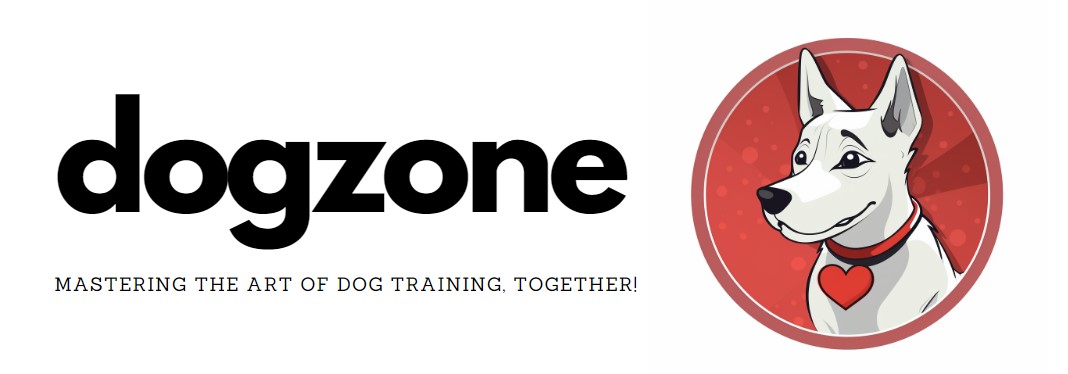
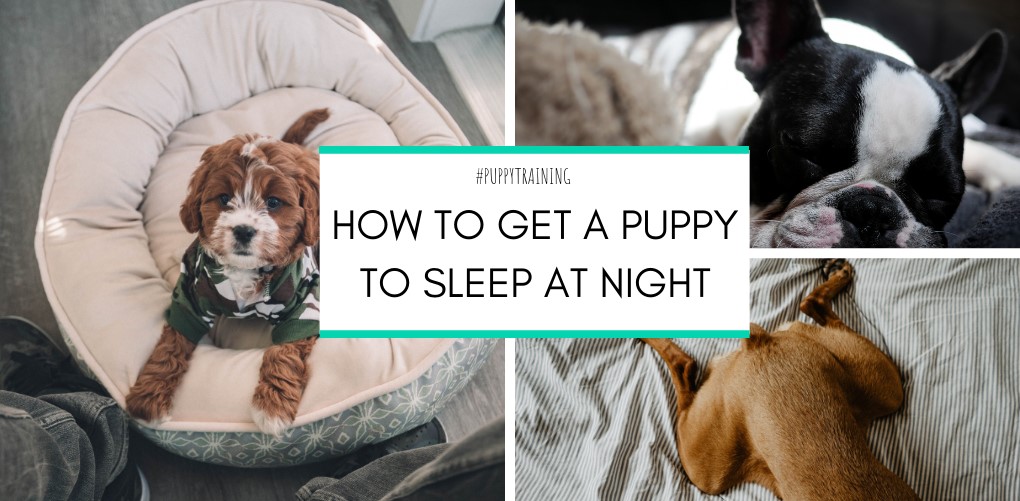
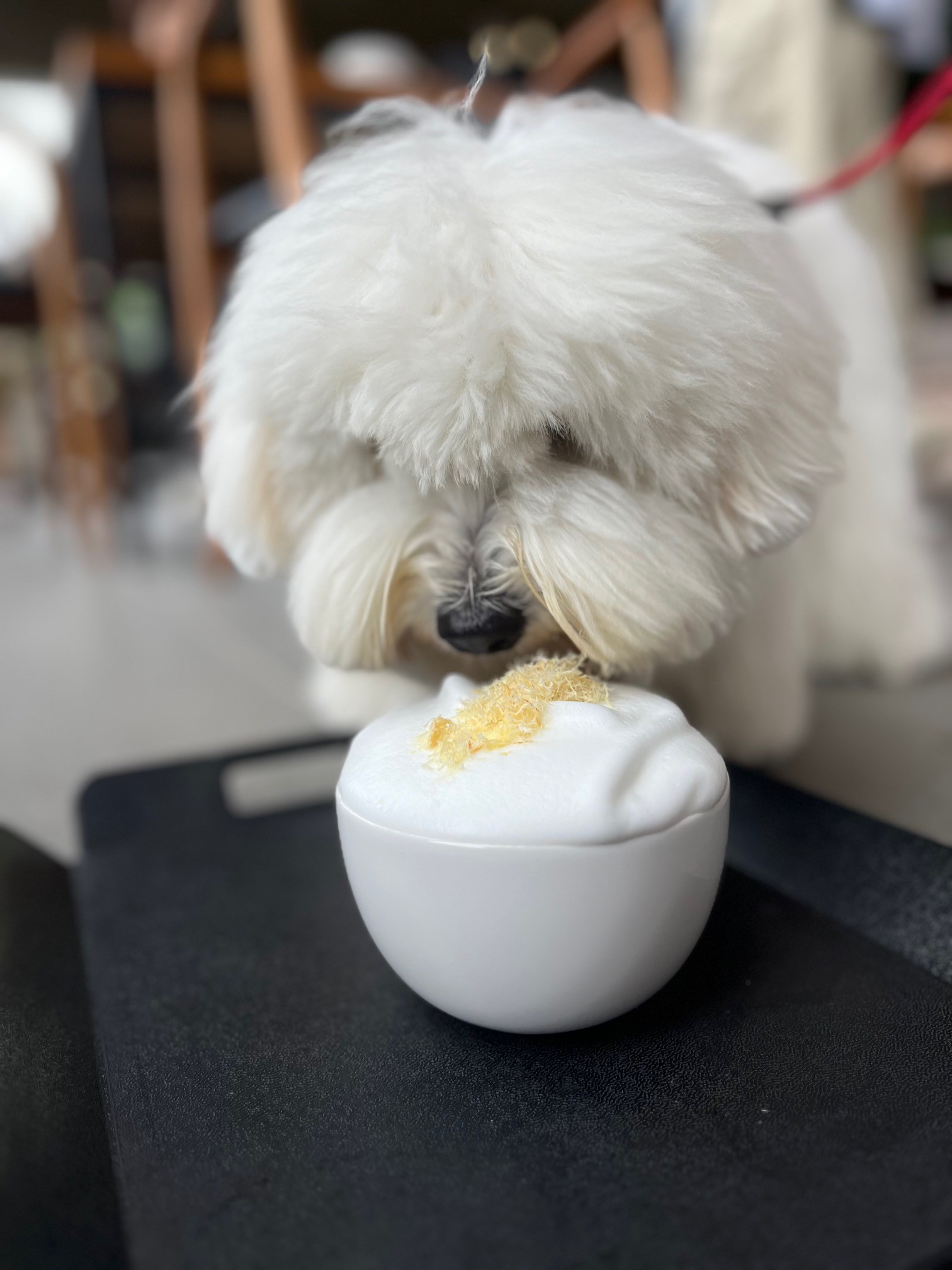
Leave a Reply